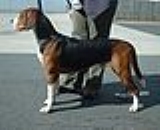
Hamiltonstövare
Encyclopedia
The Hamiltonstövare is a breed
of dog
, bred as a hunting hound
. The breed was developed in Sweden
by the founder of the Swedish Kennel Club, Count Adolf Hamilton. Its ancestry includes several German hounds as well as English Foxhound
s and Harriers
.
The breed is known by the white blaze on the head, down the neck, four white paws, and a white tail tip. He differs from an English Foxhound in that his frame is lighter.
A mixture of black and brown undesirable, as is a preponderance of any of the three permissible colours.
The Hamiltonstovare is its "own hound," and although it is friendly and gregarious, it naturally defers to doing what it wants rather than what might be requested of it. It takes enthusiasm and praise to persuade the Hamiltonstovare to comply with its owner's requests, but it'll do it if it's inspired.
Bitches 49-57 cms (19 ¼ - 22 ½ ins). The ideal size is 53 cms (21 ins).
Dog breed
Dog breeds are groups of closely related and visibly similar domestic dogs, which are all of the subspecies Canis lupus familiaris, having characteristic traits that are selected and maintained by humans, bred from a known foundation stock....
of dog
Dog
The domestic dog is a domesticated form of the gray wolf, a member of the Canidae family of the order Carnivora. The term is used for both feral and pet varieties. The dog may have been the first animal to be domesticated, and has been the most widely kept working, hunting, and companion animal in...
, bred as a hunting hound
Hound
A hound is a type of dog that assists hunters by tracking or chasing the animal being hunted. It can be contrasted with the gun dog, which assists hunters by identifying the location of prey, and with the retriever, which recovers shot quarry...
. The breed was developed in Sweden
Sweden
Sweden , officially the Kingdom of Sweden , is a Nordic country on the Scandinavian Peninsula in Northern Europe. Sweden borders with Norway and Finland and is connected to Denmark by a bridge-tunnel across the Öresund....
by the founder of the Swedish Kennel Club, Count Adolf Hamilton. Its ancestry includes several German hounds as well as English Foxhound
English Foxhound
The English Foxhound is one of the four foxhound breeds of dog. They are scent hounds, bred to hunt foxes by scent.-Appearance:The English Foxhound is about 21-25 inches tall to the withers, and weighs anywhere between 65-75 pounds, although some English Foxhounds bred for the show ring can be...
s and Harriers
Harrier (dog)
The Harrier is a small to medium sized dog breed of the hound class,used for hunting hares by trailing them. It resembles an English Foxhound but is smaller, though not as small as a Beagle.-Appearance:...
.
The breed is known by the white blaze on the head, down the neck, four white paws, and a white tail tip. He differs from an English Foxhound in that his frame is lighter.
General Appearance
Rectangular, well proportioned, giving impression of great strength and stamina. Tricoloured.Head and Skull
Head longish, rectangular, with slightly arched and moderately broad skull. Occiput not too prominent. Stop well defined but not over pronounced. Jowls not too heavy. Muzzle fairly long, large and rectangular. Bridge of nose straight and parallel to line of skull. Nose always black, well developed with large nostrils. Upper lips full but not too overhanging.Ears
Set fairly high, when drawn alongside jaw, ears extend to approximately half-way along muzzle and should be raised only slightly above skull when responding to call. Soft with straight fall and fore edge not folded out.Mouth
Jaws strong, with a perfect, regular and complete scissor bite, i.e. upper teeth closely overlapping lower teeth and set square to the jaws.Forequarters
Shoulders muscular and well laid back. When viewed from front forelegs appear straight and parallel. Upper foreleg long and broad and set at a right angle to shoulder blade. Elbows set close in to body.Body
Back straight and powerful. Strong, broad, muscular loin. Croup slightly inclined. Chest deep, ribs moderately sprung, back ribs proportionately long. Belly slightly tucked up.Hindquarters
Strong and parallel when viewed from behind. Well angulated, muscle well developed and broad when seen from side.Tail
Set on low, in an almost straight continuation of line of back. In length reaches hock. Fairly wide at base and narrowing off towards tip. Held in straight position or curving slightly in sabre-like shape. Not carried above the backline when moving.Coat
Coat consists of two layers. Undercoat short, close and soft, especially thick during winter. Upper coat strongly weather-resistant lying close to body. On underside of tail, ordinary hair quite long but not forming a fringe. Ample hair between pads.Colour
Upper side of neck, back, sides of trunk and upper side of tail black. Head and legs, as well as side of neck, trunk and tail brown. White markings as follows: blaze on upper part of muzzle, underside of neck, breast and tip of tail, lower legs and feet.A mixture of black and brown undesirable, as is a preponderance of any of the three permissible colours.
Temperament
A typical hound in temperament- sweet and friendly to all- the Hamiltonstovare is also a hardworking hunter. It is happy to be with its family, but it is also happy to be out hunting.The Hamiltonstovare is its "own hound," and although it is friendly and gregarious, it naturally defers to doing what it wants rather than what might be requested of it. It takes enthusiasm and praise to persuade the Hamiltonstovare to comply with its owner's requests, but it'll do it if it's inspired.
Size
Dogs 53-61 cms (21-24 ins). The ideal size is 57 cms (22 ½ ins).Bitches 49-57 cms (19 ¼ - 22 ½ ins). The ideal size is 53 cms (21 ins).

